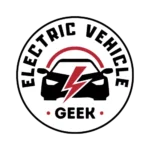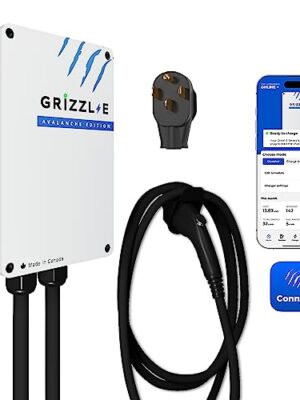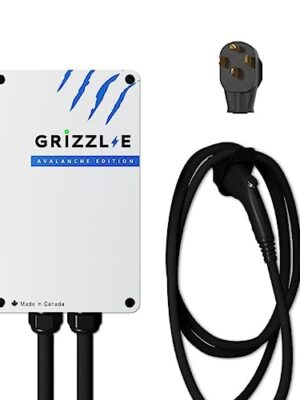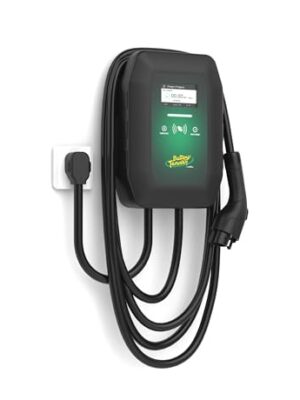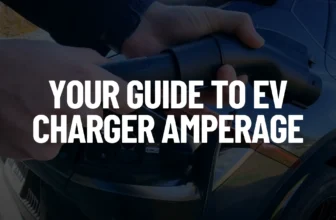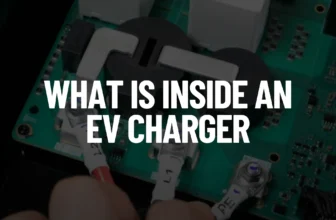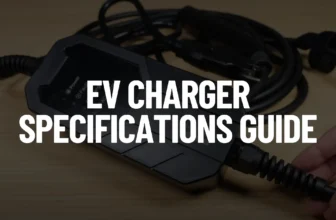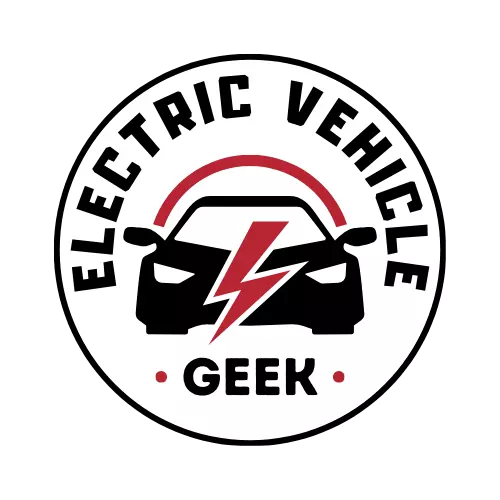In our Level 2 Jeep 4xe charger installation guide, we delve into everything you need to know about installing an aftermarket Jeep 4xe Charger. From selecting the best Jeep 4xe charger options to assessing your electrical panel’s readiness and mastering installation techniques, we provide clear, expert advice for a smooth and efficient charging setup.
When we initially reviewed the best Jeep 4xe chargers on Jeep Runner, our readers requested detailed installation steps. In response, this guide not only reviews the chargers we tested for charging the Jeep 4xe but also provides expert, step-by-step instructions for installation. From selecting the best EV charger options to assessing your electrical panel’s readiness and navigating installation methods, we ensure a seamless charging experience.
This guide covers the installation of Level 2 EV chargers for the Jeep 4xe.
Looking for a Level 1 charging setup instead? Check out our Jeep 4xe Level 1 Charger Installation Guide. Are you unsure which EV charger is right for you? Start with our Jeep Wrangler 4xe At-Home Charging Options Guide.
Table of Contents
Jeep 4xe Charger Installation Guide
After purchasing a Jeep 4xe Level 2 charger, the next step is the installation. Improper installation can pose serious risks of fire, electrical shock, and even injury. As professional EV charger installers, we have first-hand experience and training in wiring the Jeep 4xe branch circuit wiring that meets safety standards.
In this guide, we’ll highlight the best Jeep 4xe Level 2 EV chargers, walk you through assessing your home’s electrical system for compatibility, explain how to install both hardwired and plug-in chargers, and recommend upgrades and accessories to enhance your Jeep 4xe charging experience.
Best Jeep 4xe Level 2 Chargers
The Jeep 4xe’s onboard charger is limited to 32 amps (7.2 kW), so pairing it with a J1772 Level 2 charger rated for 32 amps ensures full compatibility and fast, efficient charging. This setup can fully recharge the 17 kWh battery in about two hours, offering the best balance of speed, system protection, and long-term battery health.
Learn more in our full Jeep Wrangler 4xe At-Home Charging Options Guide.
From our guide: below are our top recommended chargers for the Jeep 4xe, each equipped with built-in amperage controls and advanced safety features, allowing you to set the output precisely to 32 amps for maximum compatibility, protection, and charging efficiency.
#1 Best Jeep 4xe Smart Charger: Grizzl-E Smart Connect Level 2 (EV) Charger
| General | ||||||||||
|---|---|---|---|---|---|---|---|---|---|---|
| ||||||||||
| Power | ||||||||||
| ||||||||||
#2 Best Security Features Jeep 4xe Charger: Autel AC Elite In-Body Holster EV Charger
| General | ||||||||||
|---|---|---|---|---|---|---|---|---|---|---|
| ||||||||||
| Power | ||||||||||
| ||||||||||
#3 Best Jeep 4xe Dumb Charger: Grizzl-E Level 2 EV Charger
| General | ||||||||||
|---|---|---|---|---|---|---|---|---|---|---|
| ||||||||||
| Power | ||||||||||
| ||||||||||
Learn More: We Tested the Grizzl-E Classic EV Charger on a Jeep Wrangler 4xe
#4 Best all-around Jeep 4xe Charger: Battery Tender eCharge 48 AMP EV Charger
| General | ||||||||||
|---|---|---|---|---|---|---|---|---|---|---|
| ||||||||||
| Power | ||||||||||
| ||||||||||
Pre-Installation Assessment
The Jeep 4xe features a 17 kWh lithium-ion battery and a 32-amp onboard charger, ideal for Level 2 charging. To optimize Level 2 charging, a 32-amp Level 2 EV charger is recommended.
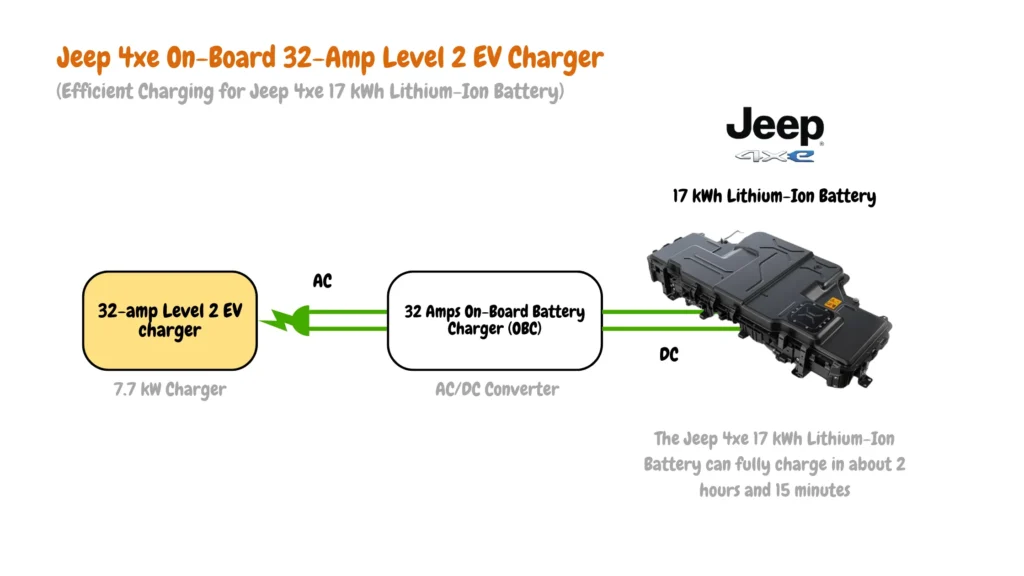
Consider installing your charger on a dedicated 40-amp circuit breaker for optimal safety and performance. Adhering to the 80/20 rule ensures your electrical system isn’t overloaded during charging. This rule dictates that circuits supplying continuous loads, such as EV chargers, should not exceed 80% of their capacity to prevent overheating and ensure safe operation.
Professional installation of the Jeep 4xe charger should mirror the electric vehicle branch circuit shown below:

Electrical Panel Assessment
When assessing the electrical panel for installing a 32-amp Jeep 4xe charger, it’s crucial to ensure safety and compatibility with your home electrical system. The electrical panel should have a breaker slot that should accommodate a 40-amp dedicated circuit breaker.
The electrical panel should also have a Wireway or “wire channel” that can neatly route and organize 8 AWG electrical wires from the main electrical panel to the 40 amps EV charger, and from the 40 amps to the knockouts or “cable exit points,” directing the 8AWG wires to the Jeep 4xe charger NEMA outlet.
For Jeep 4xe owners using a non-networked charger like the Grizzl-E Classic but still wanting smart EV charging capabilities, the electrical panel should support the addition of a smart meter and its sensors. These meters monitor real-time energy usage and enable features like load balancing, time-of-use scheduling, and energy tracking for more efficient charging.
For Jeep 4xe owners planning to integrate renewable energy with their EV charging setup, the electrical panel should be capable of supporting a transfer switch, smart meter, and the necessary sensors and wiring for solar or other renewable energy sources.
The diagram below shows an electric vehicle branch circuit for connecting a Jeep 4xe charger with renewable energy sources.
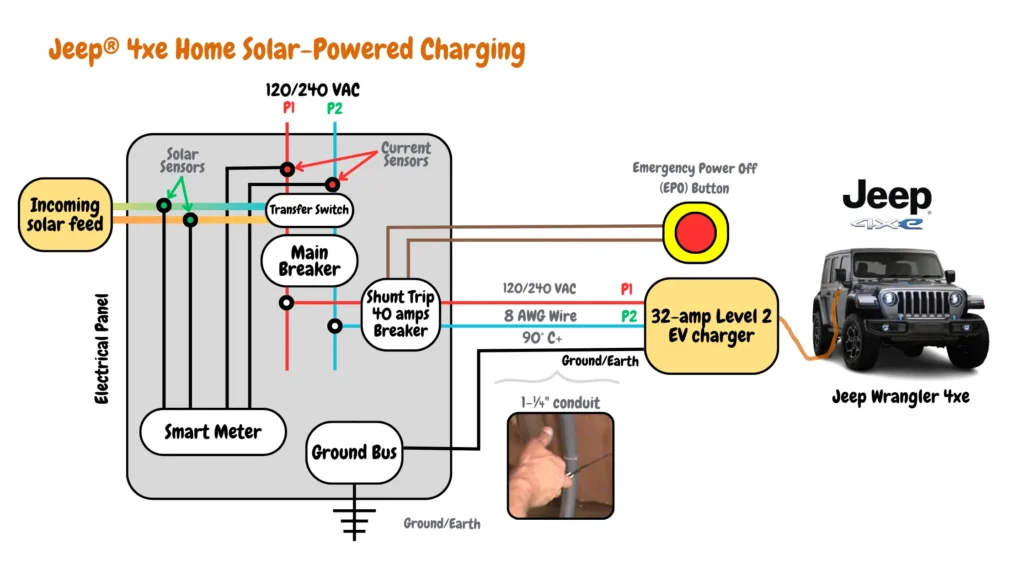
Electrical Panel Upgrade
After the electrical panel assessment, you might need an electrical panel upgrade, depending on the electrical panel space availability and also electrical compatibility. Here is a guide on some of the factors that might require an electrical panel upgrade to accommodate your Jeep 4xe charger.
A 100-amp electrical panel is enough to accommodate your Jeep 4xe charger installations. Depending on the home electrical panels installed, there should be enough amperage from the 100-amp main electrical panel to accommodate a 40-amp dedicated circuit breaker.
If your main electrical panel is already near capacity, you have two options: upgrade to a higher-capacity panel, such as a 200-amp service, or install a dedicated subpanel specifically for EV charging.
Installing a Jeep 4xe Charger on Your Home’s Electrical Panel
If your main electrical panel can accommodate a 40-amp circuit breaker, has an available dedicated 40A breaker slot, and sufficient space for 8 AWG wires, you can install your Jeep 4xe charger directly in the panel. Consider additional EV charging accessories to optimize your charging experience, such as renewable energy charging accessories, load management accessories, and smart meters for enhanced management capabilities.
Depending on your aftermarket Jeep 4xe charger specifications, you have two options for installation on your main electrical panel: Plug-in and hardwired Jeep 4xe chargers.
Plug-in Jeep 4xe Charger Home’s Electrical Panel Installations
A plug-in Jeep 4xe charger offers convenient installation by simply plugging into a compatible outlet, typically a NEMA 14-50 or NEMA 6-50 receptacle. This setup is straightforward and suitable for locations where easy accessibility to an outlet is available near the charging station.
A plug-in Jeep 4xe charger allows for flexibility in relocating the charger if needed and is often favored for its simplicity in setup and use.
Jeep 4xe Home Charging: NEMA 6-50 Outlet Installation (Main Electrical Panel)
The diagram below illustrates a Plug-in Jeep 4xe charger branch circuit diagram featuring a NEMA 6-50 receptacle outlet. It details the wiring layout and connections specific to the Jeep 4xe charging system within your main electrical infrastructure.
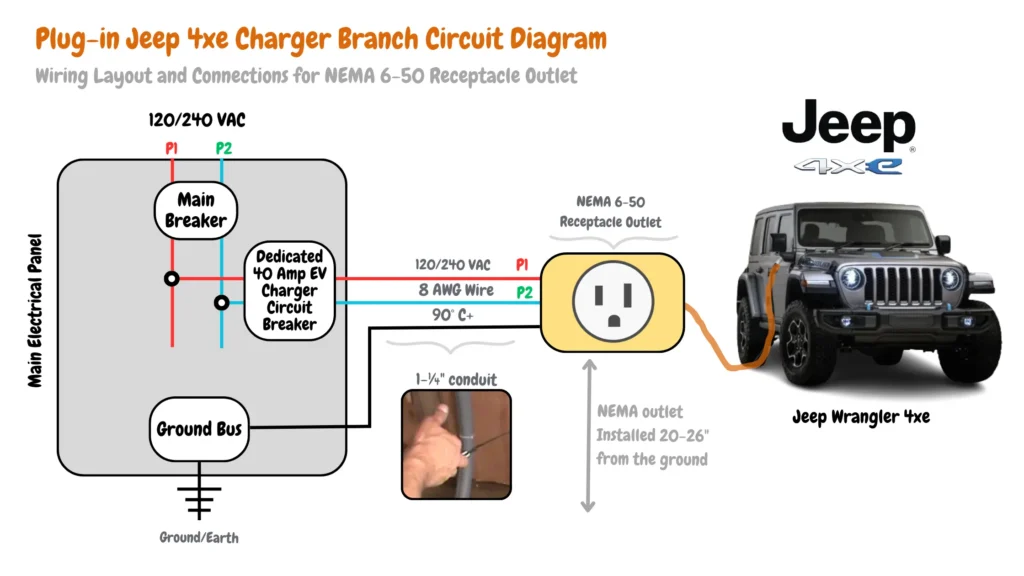
Install a NEMA 14-50 Charger for Your Jeep 4xe (Main Electrical Panel)
The diagram below shows the wiring layout for connecting a Plug-in Jeep 4xe charger to a NEMA 14-50 outlet. It’s a visual guide to integrating your charger seamlessly with your home’s electrical system.

Hardwired Jeep 4xe Charger Home’s Electrical Panel Installation
Depending on your Jeep 4xe charger specifications, you might also require a hardwired EV charger installation on your main electrical panel.
A hardwired Jeep 4xe charger is directly connected to your home’s electrical system through a dedicated circuit. This type of installation requires professional wiring directly to the main electrical panel or a dedicated subpanel.
Hardwired chargers are preferred for their permanent and secure installation, providing robust electrical connections and often supporting higher charging capacities compared to plug-in models. They are ideal for homeowners seeking a fixed, reliable charging solution with minimal maintenance and long-term durability.
The diagram below shows a hardwired Jeep 4xe charger branch circuit showing the wiring layouts, accessories, and connections specific to the hardwired Jeep 4xe charging system within your main electrical panel.
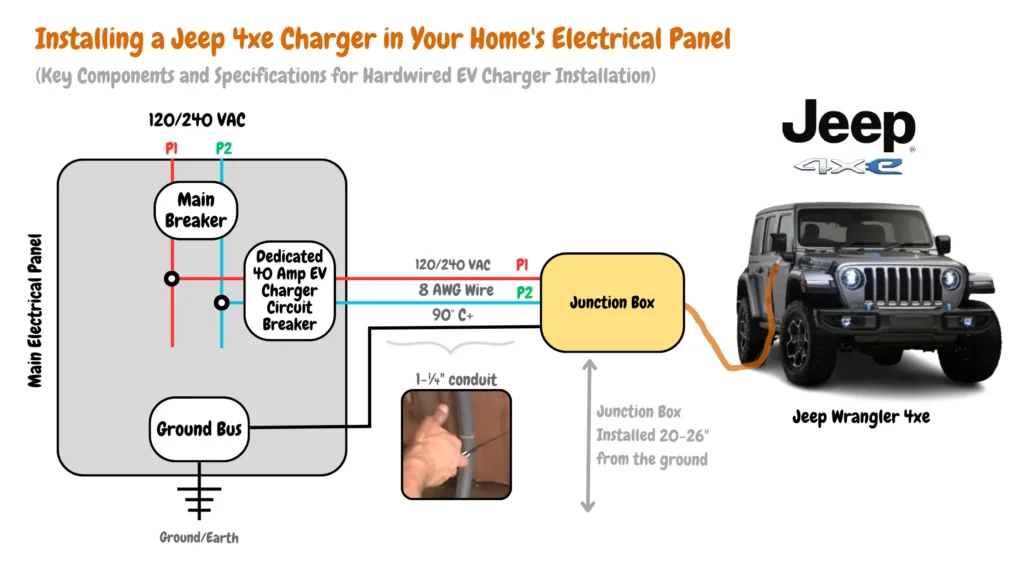
Installing a Jeep 4xe Charger on a Dedicated EV Charging Subpanel
You might also to install a Jeep 4xe charger on a dedicated EV charging subpanel if your main electrical panel cannot accommodate the additional load required for a 32-amp Jeep 4xe charger, you might also need a dedicated EV charger subpanel to help in organizing and managing your Jeep 4xe charger branch circuit.
We recommend installing a Jeep 4xe charger on a dedicated EV charging subpanel to ensure the safety and reliability of your main electrical panel. This setup supports the increased demand for electric vehicle charging without compromising existing electrical loads or creating potential hazards. Having a dedicated circuit breaker in the subpanel also simplifies maintenance and troubleshooting for your Jeep 4xe charger installation.
Plug-in Jeep 4xe Charger (Subpanel Installation)
Installing a plug-in Jeep 4xe charger on a dedicated subpanel offers convenience and flexibility. This setup involves connecting the charger to a NEMA 14-50 or NEMA 6-50 receptacle mounted on the subpanel. It provides a straightforward installation process with the advantage of easily relocating the charger if necessary, while ensuring a dedicated and safe electrical supply specifically for EV charging.
Jeep 4xe Home Charging: NEMA 6-50 Outlet Installation (Subpanel Installation)
The diagram below illustrates the installation of a Plug-in Jeep 4xe charger on a dedicated subpanel, specifically showcasing the wiring layout and connections for the NEMA 6-50 outlet. It details the integration of the Jeep 4xe charging system within both your main electrical system and the dedicated EV charging subpanel.

Installing a NEMA 14-50 Charger for Your Jeep 4xe (Subpanel Installation)
The diagram below depicts the installation of a Plug-in Jeep 4xe charger on a dedicated subpanel, highlighting the wiring layout and connections for the NEMA 14-50 outlet. It provides a comprehensive view of how the Jeep 4xe charging system integrates with both your main electrical system and the dedicated EV charging subpanel.
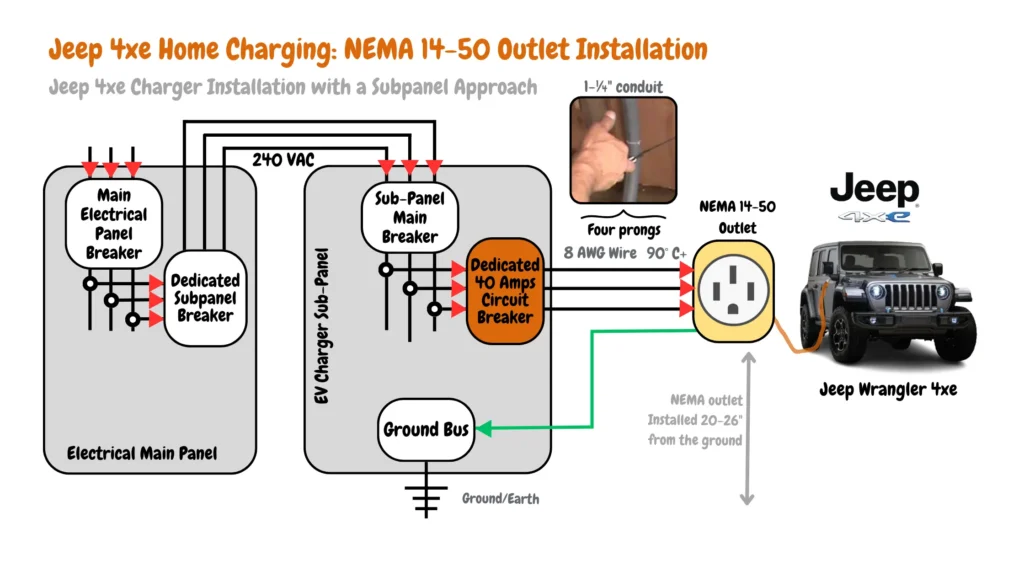
Hardwired Jeep 4xe Charger (Subpanel Installation)
For a permanent and robust charging solution, a hardwired Jeep 4xe charger installed on a dedicated subpanel is recommended. This installation requires professional wiring directly to the subpanel or main electrical panel, ensuring a secure electrical connection and supporting higher charging capacities.
Hardwired Jeep 4xe Charger (Subpanel Installation) provides reliability and minimal maintenance, making it suitable for homeowners seeking a fixed and efficient EV charging solution integrated into their electrical infrastructure.
The diagram below illustrates a hardwired Jeep 4xe charger branch circuit, detailing the wiring layout and circuit breakers in both the main electrical panel and the dedicated sub-panel.
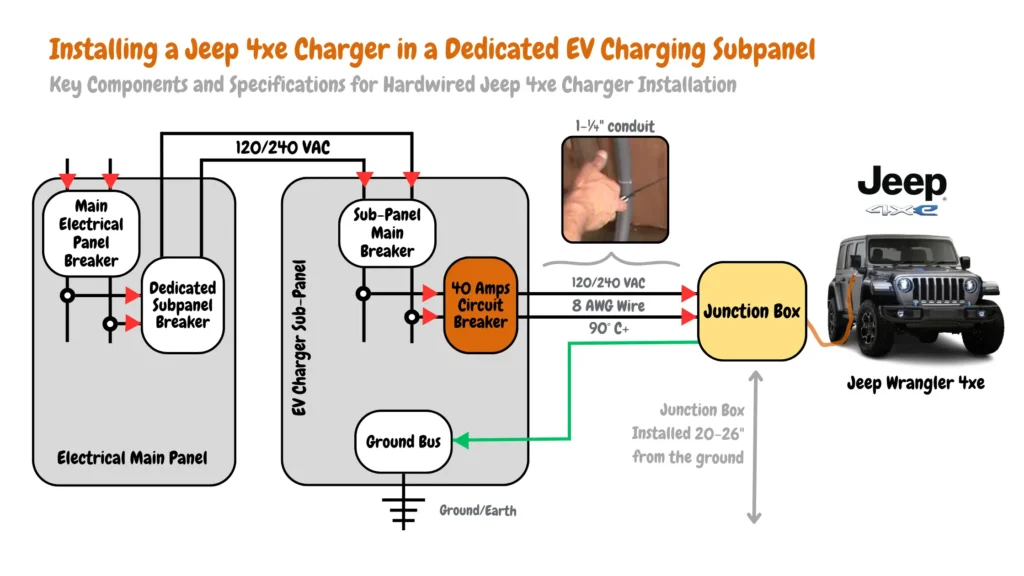
Conclusions.
Choosing and installing the right charger for your Jeep 4xe is crucial for optimizing its performance and extending its electric range effectively. Whether you opt for a plug-in charger directly on your main panel or a dedicated sub-panel installation for a hardwired setup, careful planning and assessment ensure safety and efficiency.
With the insights gained from this guide—from pre-installation assessments to the installation itself—you’re equipped to make informed decisions that align with your charging needs and environmental goals.

James Ndungu is a certified EV charger installer with over five years of experience in EVSE selection, permitting, and installation. He holds advanced credentials, including certification from the Electric Vehicle Infrastructure Training Program (EVITP) and specialized training in EV charging equipment and installation, as well as diplomas in EV Technology and Engineering Fundamentals of EVs. Since 2021, James has tested dozens of EV chargers and accessories, sharing expert insights into the latest EV charging technologies.
